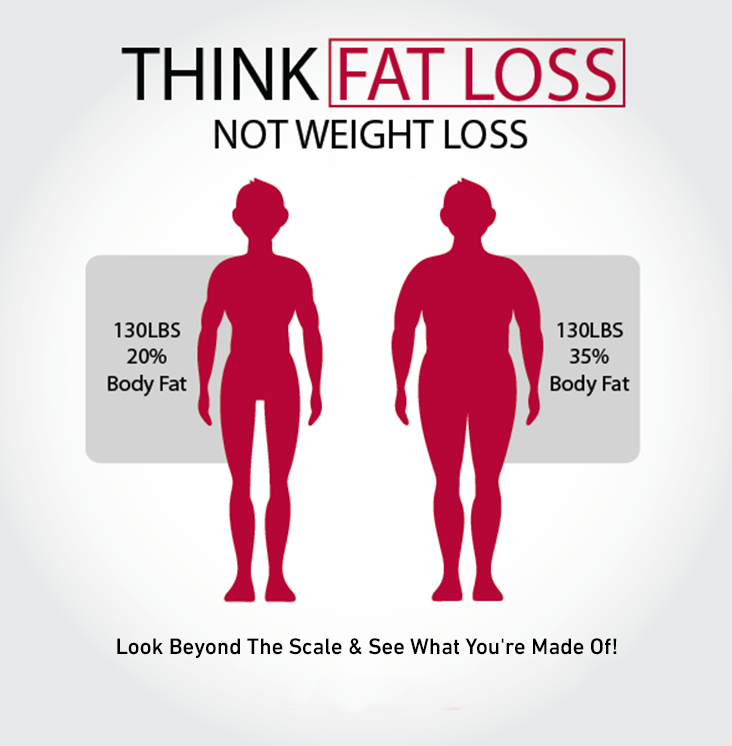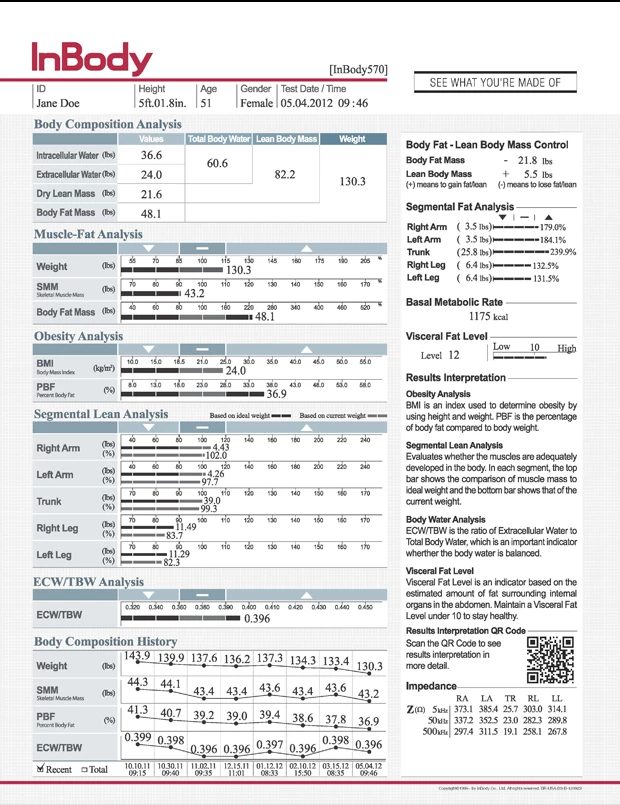Body Composition Analysis

At OC Fitness Coach we use the InBody570 body composition analyzer to measure body fat, lean body mass and body water. This isn’t a cheap $200-$300-dollar hand-held gadget bought on Amazon or Dick’s Sporting Goods. The InBody is a high-end device commonly used in hospitals, research settings, collegiate and pro sports to monitor subjects and athletes. It uses Bioelectrical Impedance Analysis (BIA) which is a method for measuring body composition based on the rate at which an electrical current travels throughout the body. The test is quick, simple, painless and gives us very accurate measurements of your health, and has been shown to correlate with dual-energy x-ray absorptiometry (DXA) which is considered the Gold-Standard. (1) With some of the specific biomarkers detailed below we can track changes in the data and see which way your health is trending. If your health therapies are working for you, the InBody results sheet will trend in the right direction.
What does the 570 measure specifically and what does that tell you about your health?
1. Muscle Mass and why is it important to your health?
The printout (example at the bottom of page) will show us Skeletal Muscle Mass in pounds as well as a Segmental Lean Analysis expressing exactly how much muscle you have in your trunk, both arms and both legs. Based on your current age, weight and height you will see if you are “under normal”, “normal” or “above normal”. Many people assume muscle is just for looks or being strong, however it is much more than that, and is a significant measurement for overall health. It is what gives you energy, balances your hormones, helps in detoxifying the body, supports immunity and can be affected by malabsorption of nutrients. If your health goes down your muscle mass will decrease. It is essential to keep your eye on muscle mass especially as you age, as it is affected by your overall state of being. (2)
2. Metabolic Rate and why it’s important to your health?
The InBody can tell us how many calories your body burns at rest. Your metabolic rate is affected by muscle mass, your thyroid gland and adrenal gland. If there are any dysfunction in these areas, your metabolic rate will likely reflect it. (3) Generally speaking, the higher the number the better. Knowing your metabolic rate can also be very helpful with your daily nutrition goals. You can more accurately target your nutrition in terms of calories, fat, protein, carbohydrates, as well as micronutrients
3. Bodyfat and why it’s important to your health?
We want to aim for the “ideal” bodyfat range regardless of scale weight. High bodyfat mass and inflammation are directly related. (4) However, bodyfat that is too low may affect immune function, increase the risk of disease and fertility issues, as well as negatively affect fatigue, brain function and depression. The InBody can also divide into segmental fat analysis between upper and lower body limbs as well as the trunk. Depending on where you are storing the fat, we can gain insight and investigate further as to the status of your hormone health. Optimal levels of bodyfat are important for making hormones and maintaining your skin. Too much or too little can be problematic.
4. Hydration status and why it’s important to your health?
This is one of the more common nutritional deficiencies in people, and a lot of new clients that come in are not even aware of it. Joint health, brain health, skin health and organ function all decline when you are dehydrated. (5) Chronic dehydration can take months of rehydration to correct itself. Along with total body water, the InBody can detect intracellular and extracellular water. The extracellular/total body water ratio (ECW/TBW) analysis can display indicators or cell membrane health, toxicity and can track inflammation.
5. Visceral Fat and why is it important to your health?
With our visceral fat read out we can get a true estimate of how much fat is around your internal organs, which many have argued is even more of a health concern than the fat you see on the outside. Health risks associated with high levels of visceral fat include type 2 diabetes, heart disease, some forms of cancer, and Alzheimer’s disease. (6) Once again, there can be negative disruptions in hormones if visceral fat levels are not within range. Generally, lower waist circumference means lower visceral fat, however that is not always the case, as you can be “skinny” on the outside, but “fat” on the inside.
Summary
As you can see, this highly accurate body composition analyzer gives us a treasure chest of information on your health that cannot be seen on a simple weight scale. Points 1-5 addressed above will give you and us coaches very clear directions on what changes we want to make to your lifestyle therapies (nutrition, exercise, sleep, stress). An InBody analysis is advised every 4-6 weeks. We will help you understand your scores and discuss strategies with you on how to optimize your health. CLICK HERE TO CONTACT US and get a FREE InBody scan (currently priced at $85.00 per scan at a local University Weight Loss Clinic) and find out what your stats tell you about your health.
REFERENCES
1. Antonio, et al. “Comparison of Dual-Energy X-Ray Absorptiometry (DXA) versus a Multi-Frequency Bioelectrical Impedance (InBody 770) Device for Body Composition Assessment after a 4-Week Hypoenergetic Diet.” Journal of Functional Morphology and Kinesiology, vol. 4, no. 2, 2019, p. 23., doi:10.3390/jfmk4020023.
2. Kraemer, William J., et al. “The Effects of Short-Term Resistance Training on Endocrine Function in Men and Women.” European Journal of Applied Physiology, vol. 78, no. 1, Jan. 1998, pp. 69–76., doi:10.1007/s004210050389.
3. Lazzer S, Bedogni G, Lafortuna CL, et al. “Relationship Between Basal Metabolic Rate, Gender, Age, and Body Composition in 8,780 White Obese Subjects.” Obesity. 2010;18(1):71-78.
4. Monteiro R, Azevedo I. Chronic inflammation in obesity and the metabolic syndrome. Mediators Inflamm. 2010;2010:289645. doi:10.1155/2010/289645
5. El-Sharkawy AM, Sahota O, Lobo DN. Acute and chronic effects of hydration status on health. Nutrition Reviews. 2015;73(suppl 2):97-109.
6. Rattarasarn C, Leelawattana R, Soonthornpun S, et al. Regional abdominal fat distribution in lean and obese Thai type 2 diabetic women: relationships with insulin sensitivity and cardiovascular risk factors. Metabolism. 2003;52(11):1444-1447.




